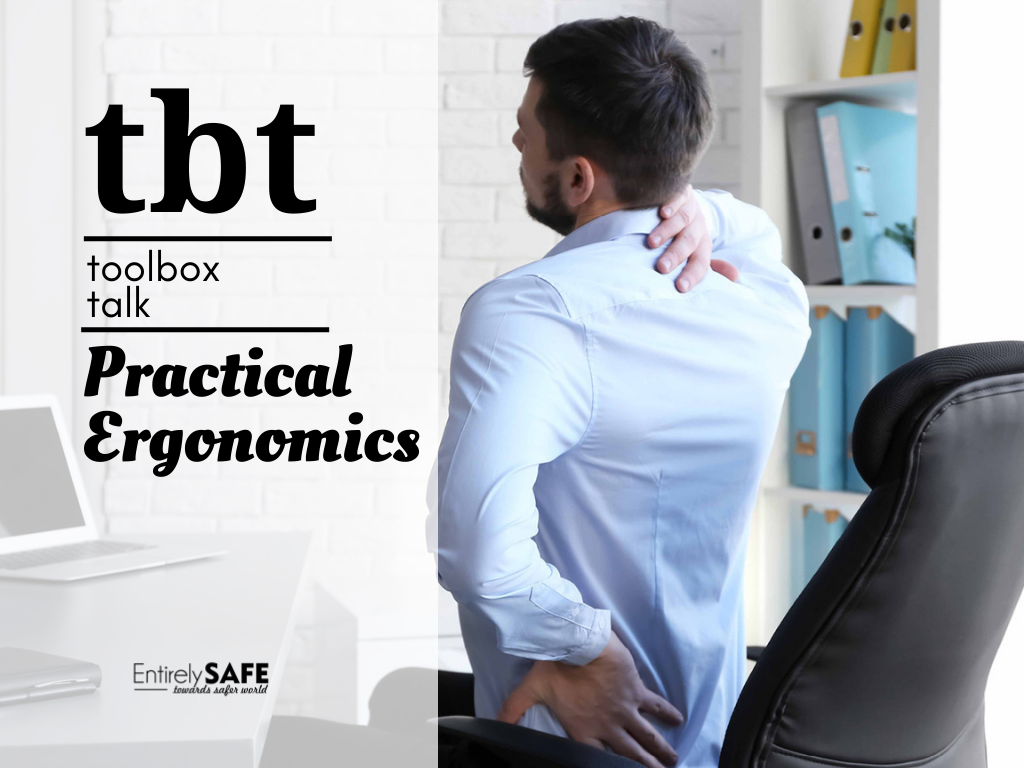Pratical Ergonomics Toolbox Talk

Before the Toolbox Talk
This safety talk is designed for discussion leaders to use in preparing safety meetings. Set a specific time and date for your safety meeting. Publicize your meeting so everyone involved will be sure to attend. Review this safety talk before the meeting and become familiar with its content.
Make notes about the points made in this talk that pertain to your workplace. You should be able to present the material in your own words and lead the discussion without reading it.
Seating space is not absolutely necessary, but arrangements should be made so that those attending can easily see and hear the presentation. Collect whatever materials and props you will need ahead of time. Try to use equipment in your workplace to demonstrate your points.
Give the safety talk in your own words. Use the printed talk merely as a guide. The purpose of a safety meeting is to initiate a discussion of safety problems and provide solutions to those problems. Encourage employees to discuss hazards or potential hazards they encounter on the job. Ask them to suggest ways to improve safety in their area. Don’t let the meeting turn into a gripe session about unrelated topics. As a discussion leader, it’s your job to make sure the topic is safe. Discussing other topics wastes time and can ruin the effectiveness of your safety meeting.

Toolbox Talk: Pratical Ergonomics
NOTE TO THE DISCUSSION LEADER: The basic theme of this talk is to provide information to your employees that can be used to improve their work stations within your department. To prepare for this talk, survey your department to determine what practical ergonomic solutions can be implemented to improve the safety and efficiency of your overall operation. Review the following case studies with your employees to stimulate group discussion about what they can do to improve the overall safe operation of your department.
What does ergonomics mean? Simply put, it is fitting the workplace to the worker to reduce physical and mental stress.
Ergonomics Incident Case Study 1
Joe, who works on a manufacturing assembly operation, injured himself one afternoon while bending over to pick up a basket of parts that weighed 25 pounds. Joe complained to his supervisor that while he was bending over his back started to hurt. Joe was sent to the doctor who diagnosed his injury as a pulled back muscle. He was off work for several weeks because of the injury.
When he returned, he and his supervisor investigated the possible cause of Joe’s injury. They discovered that bending over to pick up the basket of parts and then placing it on the workbench was unnecessary. Instead, Joe and his foreman decided to stack three pallets under the basket, making it the same height as the workbench. That way they eliminated the possibility of anyone having to bend over to pick up the basket of parts.
NOTE TO THE DISCUSSION LEADER: Ask the group what other methods could be used to reduce the need to bend over and pick up the basket of parts.
Possible solutions:
- Purchase a scissors jack or hydraulic lift table.
- Re-evaluate the assembly layout and install a roller conveyor to move the parts to the workstation.
Ergonomics Incident Case Study 2
Sally, an electronics assembly operator, works on a small trim press which is operated by two-hand controls. After the third day on the job, she started to experience some pain in her shoulders by the end of the shift. Sally mentioned this to her supervisor who then initiated an investigation to determine the cause. The investigation revealed that the two-hand controls were 10 inches above Sally’s shoulders while she was seated at her workstation.
NOTE TO THE DISCUSSION LEADER: Ask the group what could be done to eliminate the need to reach 10 inches above shoulder height to operate the press.
Possible solutions:
- Raise Sally’s chair.
- Move the two hand controls to the bench area and guard them properly to prevent accidental actuation of the press.
Ergonomics Incident Case Study 3
Ed, a polisher working on small parts, started to experience some discomfort and fatigue in his wrists. Before an injury could occur, Ed decided to experiment. He took an empty box and placed it under one end of the carton holding his parts. By placing the parts at an angle it was easier for Ed to take the parts from the carton and do his polishing operation. By making this simple modification, Ed reduced the number of times that he had to reach over the edge of the carton to pick up the parts. The change also allowed him to straighten his hand to pull the parts out, reducing wrist fatigue.
Although there had been no injury or accident, in this case, it shows that there are many things we can do to prevent injuries and accidents in the workplace.
In order to improve our safety program, we are asking all employees to review their operations and suggest any ergonomic modifications to management.
Interactive Discussion
- Have you or someone you know been injured or nearly injured while carrying out this activity? What happened?
- How can we stay safe today?
- What do we do at the worksite to prevent injuries related to this activity?
After the Toolbox Talk
At the end of the meeting, ask employees to sign a sheet on the back of this talk as a record that they attended the safety meeting. Keep this talk on file for your records.

